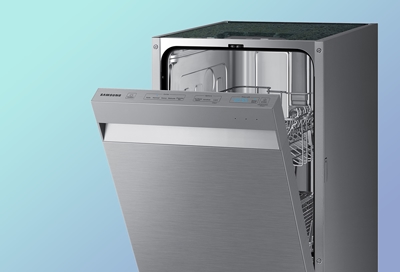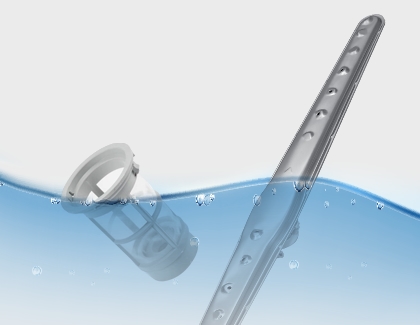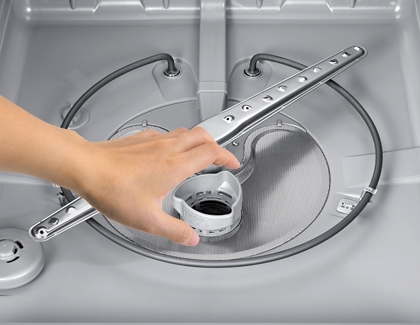How To Register My Samsung Dishwasher
Routine and deep clean your Samsung dishwasher

Since your dishwasher's job is to clean, it's easy to forget it has its own cleaning needs. But proper cleaning is an important part of dishwasher maintenance. Not only does it improve performance, it reduces unnecessary repairs over the dishwasher's lifetime. Check out our tips for day-to-day, routine wipe-downs, as well as how to tackle a deep cleaning whenever your dishwasher needs it.
Caution: Do not use bleach in a dishwasher with a stainless steel interior (which most of our dishwashers have). This may damage or discolor the interior.
A routine clean should be done regularly and whenever you notice a buildup of debris, stains, or other marks on or inside your dishwasher. Here are some tips for cleaning the outside and inside of your dishwasher.
-
When performing a routine clean, gently wipe down the outside of the dishwasher and control panel with a soft, damp, cloth to remove any stains.
-
If your dishwasher came with a cutlery pad, turn it over after each use to keep it clean. You can remove white spots and odors from the pad by running the Self Clean cycle. Make sure the dishwasher is empty during this cycle and do not add detergent.
-
To clean the interior, place an 8 ounce cup of distilled white vinegar upright in the lower basket, and then run a Sanitize cycle by selecting the Sanitize button. This cycle will reach 163°F during the final rinse cycle for optimum sanitization.
Note: The Sanitize feature is not available when running Delicate and Rinse Only cycles. The Sanitize light will blink until it reaches the necessary temperature. If it keeps blinking, the water temperature requirements for the feature were not met, and you should raise the temperature of the water supply.
For more information on using the Self Clean cycle, as well as other helpful cycles on your dishwasher, check out our guide for additional options and settings.
Before deep cleaning your dishwasher, you may want to perform a routine cleaning first by following the suggestions in the previous section.
-
For a deep clean, remove the nozzles and filter. They should be soaked overnight in distilled white vinegar.
-
Distilled white vinegar will remove mineral deposits and grime that have accumulated or are causing an odor.

Many dishwashers have a removable filter to make cleaning it easier. If your model has a removable filter, see the following steps. If these steps do not match your model, refer to your user manual for the correct steps.
Note: If your manual does not provide steps, then your model does not have a removable filter. In this case, just clean the bottom of the dishwasher tub everywhere you can reach.
It is recommended that you clean the filter often. This will prevent clogged filter errors, such as 1E (which may look like IE or lE), indicating that water is not going through the filter.

Here's what to do if you have a removable filter:
-
Rotate the filter handle counterclockwise to unfasten the filter compartment door.
-
Remove the filter door, and then remove the filter that is underneath.
-
Wipe away dirt or other remains from the filter and the filter door. Allow the filter and filter door to soak in distilled white vinegar overnight, and then rinse them under running water.
-
Reinstall the filter, and then the filter door.
-
Rotate the filter door handle clockwise to lock the filter door.
Nozzles should be cleaned regularly to ensure they can rotate smoothly and spray water through each of their holes. If any of the nozzles' holes are clogged, this reduces cleaning performance and can leave food particles on dishes. See the following steps for an example of how to clean them. If these steps do not match your model, refer to your user manual for the correct steps.

-
Remove any racks that are blocking access to the nozzle.
-
Unfasten the nozzle cap by turning it counterclockwise, and then remove the upper nozzle. Some nozzles don't have a nozzle cap and can just be pulled off.
-
Clean the nozzle thoroughly using a small brush (such as a dishwashing brush or an old toothbrush). Allow the nozzle to soak overnight in distilled white vinegar, and then rinse it by running water through the nozzle. Make sure water can easily pass through all of the nozzle's holes.
-
Reinsert the nozzle, and then fasten the nozzle cap (if it has one) by turning the cap clockwise. Afterwards, check whether the nozzle is attached correctly by rotating it.
On some dishwasher models, the drain pump can be reached when the drain filter is removed. If debris is caught in the drain pump, it can cause the dishwasher to make a noise or not drain properly.
It is rare that you need to access the drain pump, but if it is accessible, the user manual for your dishwasher includes instructions for cleaning it.
Thank you for your feedback!
© 2021 Samsung Electronics America, Inc. Samsung, Samsung Galaxy and Family Hub are trademarks of Samsung Electronics Co., Ltd. All other brands, products and services, and their respective trademarks, names and logos, are the property of their respective owners. The above content is provided for entertainment and information purposes only. Consult user manual for more complete information. All information included herein is subject to change without notice. Samsung is not responsible for any direct or indirect damages, arising from or related to use or reliance of the content herein.
How To Register My Samsung Dishwasher
Source: https://www.samsung.com/us/support/answer/ANS00076793/
Posted by: freemanpinhould1981.blogspot.com

0 Response to "How To Register My Samsung Dishwasher"
Post a Comment